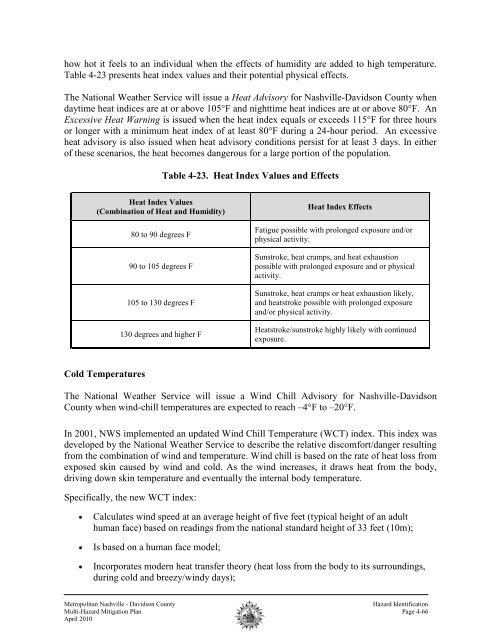2010 Metro Mitigation Plan
2010 Metro Mitigation Plan
2010 Metro Mitigation Plan
Create successful ePaper yourself
Turn your PDF publications into a flip-book with our unique Google optimized e-Paper software.
how hot it feels to an individual when the effects of humidity are added to high temperature.<br />
Table 4-23 presents heat index values and their potential physical effects.<br />
The National Weather Service will issue a Heat Advisory for Nashville-Davidson County when<br />
daytime heat indices are at or above 105°F and nighttime heat indices are at or above 80°F. An<br />
Excessive Heat Warning is issued when the heat index equals or exceeds 115°F for three hours<br />
or longer with a minimum heat index of at least 80°F during a 24-hour period. An excessive<br />
heat advisory is also issued when heat advisory conditions persist for at least 3 days. In either<br />
of these scenarios, the heat becomes dangerous for a large portion of the population.<br />
Table 4-23. Heat Index Values and Effects<br />
Heat Index Values<br />
(Combination of Heat and Humidity)<br />
80 to 90 degrees F<br />
90 to 105 degrees F<br />
105 to 130 degrees F<br />
130 degrees and higher F<br />
Heat Index Effects<br />
Fatigue possible with prolonged exposure and/or<br />
physical activity.<br />
Sunstroke, heat cramps, and heat exhaustion<br />
possible with prolonged exposure and or physical<br />
activity.<br />
Sunstroke, heat cramps or heat exhaustion likely,<br />
and heatstroke possible with prolonged exposure<br />
and/or physical activity.<br />
Heatstroke/sunstroke highly likely with continued<br />
exposure.<br />
Cold Temperatures<br />
The National Weather Service will issue a Wind Chill Advisory for Nashville-Davidson<br />
County when wind-chill temperatures are expected to reach –4°F to –20°F.<br />
In 2001, NWS implemented an updated Wind Chill Temperature (WCT) index. This index was<br />
developed by the National Weather Service to describe the relative discomfort/danger resulting<br />
from the combination of wind and temperature. Wind chill is based on the rate of heat loss from<br />
exposed skin caused by wind and cold. As the wind increases, it draws heat from the body,<br />
driving down skin temperature and eventually the internal body temperature.<br />
Specifically, the new WCT index:<br />
Calculates wind speed at an average height of five feet (typical height of an adult<br />
human face) based on readings from the national standard height of 33 feet (10m);<br />
Is based on a human face model;<br />
Incorporates modern heat transfer theory (heat loss from the body to its surroundings,<br />
during cold and breezy/windy days);<br />
<strong>Metro</strong>politan Nashville - Davidson County<br />
Hazard Identification<br />
Multi-Hazard <strong>Mitigation</strong> <strong>Plan</strong> Page 4-66<br />
April <strong>2010</strong>


